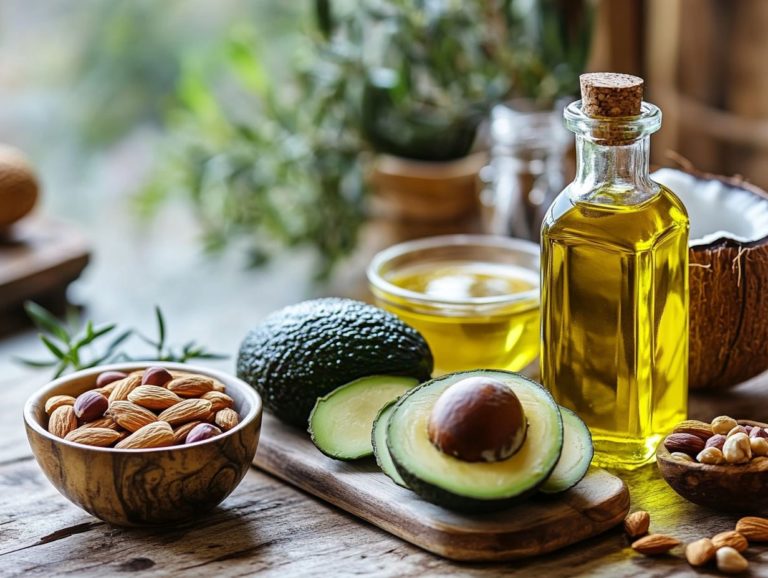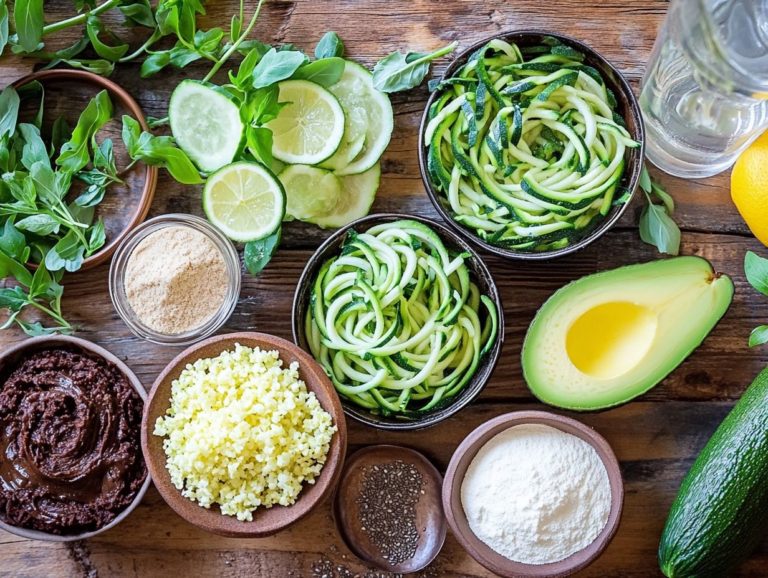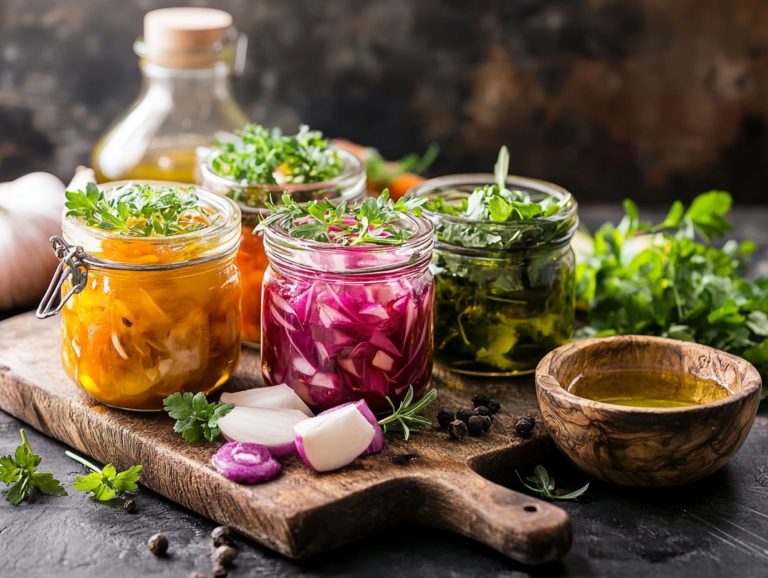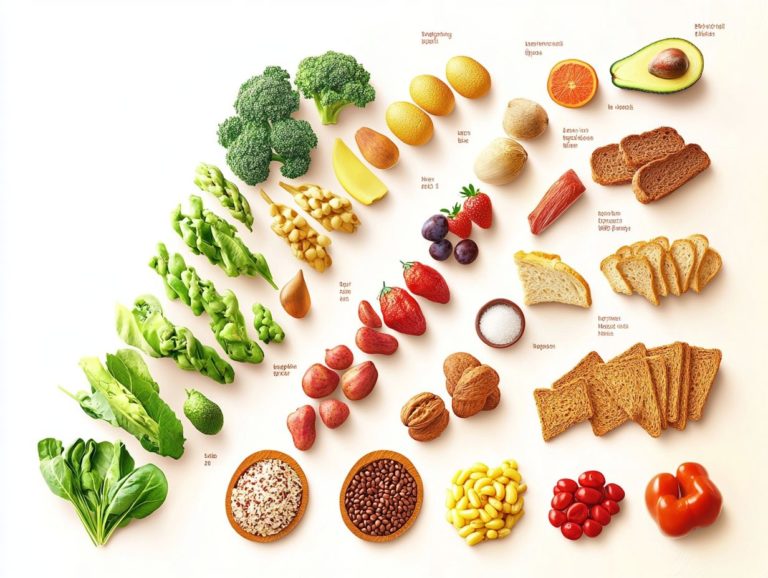How to Choose Keto-Friendly Meat Cuts
Choosing the right meat cuts is crucial for anyone navigating the keto diet. With an emphasis on high fat and low carbohydrate intake, selecting the finest keto meats can significantly enhance both your culinary experience and health journey.
This guide will assist you in identifying keto-friendly meat cuts, outlining what to avoid, and showcasing the best choices for your meals. You’ll also find delicious keto meat recipes and discover cooking techniques that elevate flavor while ensuring your meals stay aligned with your keto objectives.
Get ready to take your keto meals to the next level!
Contents
- Key Takeaways:
- What to Look for in Keto-Friendly Meat Cuts?
- What Meat Cuts to Avoid on Keto?
- 3. Grain-Fed Meats
- What Are the Best Meat Cuts for Keto?
- Cooking Tips and Techniques for Keto-Friendly Meat Cuts
- 4. Pan-Frying
- Frequently Asked Questions about Keto Meats
- What are the top keto-friendly meat cuts to choose from? (Including Grass-fed and Pasture-raised Options)
- How can I tell if a meat cut is keto-friendly? (Understanding Nutritional Value and Avoiding Processed Meats)
- What are some examples of keto-friendly red meat cuts?
- Are all poultry cuts considered keto-friendly? (Identifying Lean Protein and Fatty Cuts)
- Can I include deli meats in a keto diet? (Choosing Sugar-Free and Nutrient-Dense Options)
- How can I prepare keto-friendly meat cuts? (Cooking Tips for High-Fat Diets)
Key Takeaways:
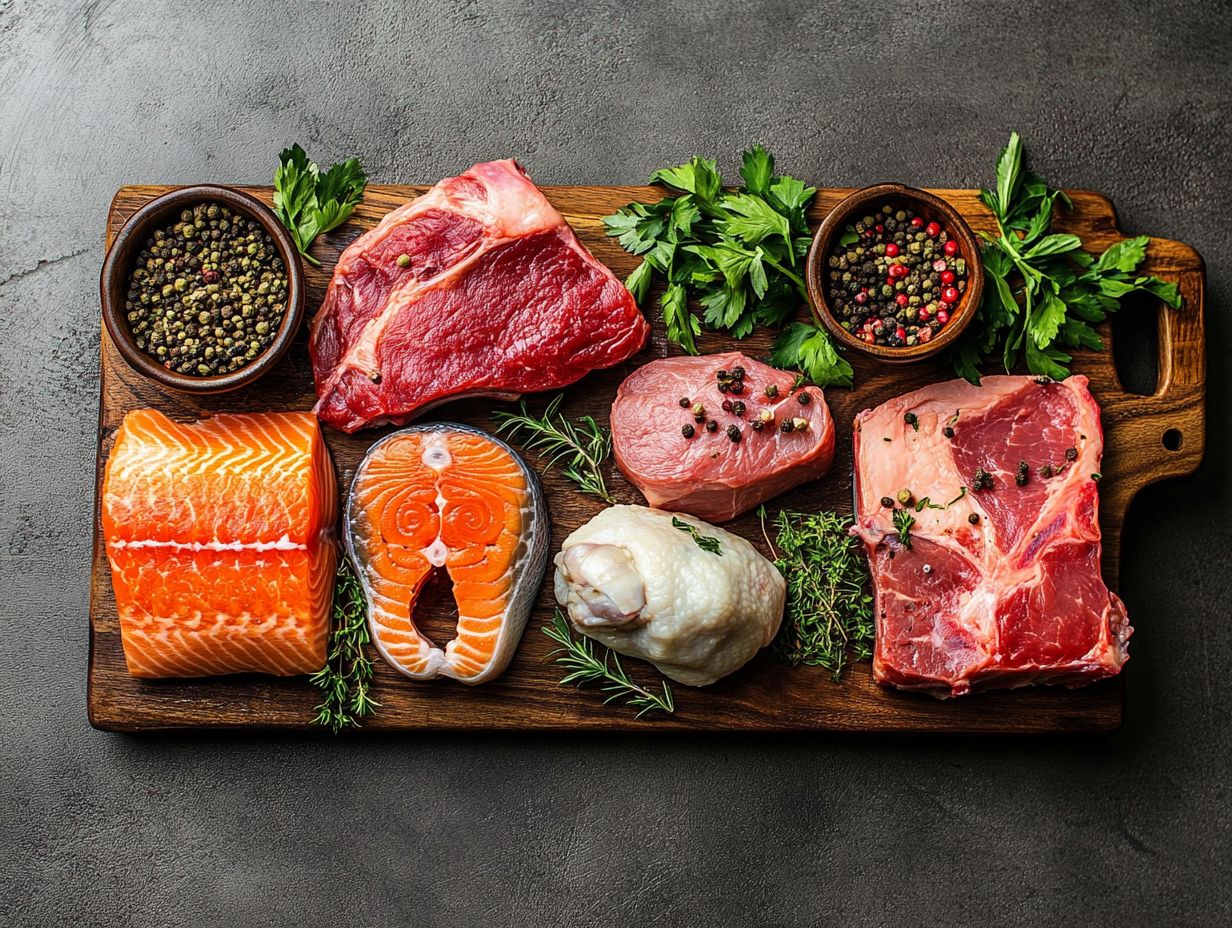
- Choose meat cuts with high fat content and low carb count for a keto-friendly diet.
- Avoid processed, high carb, and grain-fed meats on keto.
- Include fatty cuts of beef, pork, lamb, poultry, fatty fish, and organ meats in your keto meal plan. Don’t forget to add nutrient-dense options such as bison ribeye, ground beef, and chicken wings.
What to Look for in Keto-Friendly Meat Cuts?
When you embark on the keto diet, choosing the right cuts of meat becomes essential for sticking to a low-carb diet. In this realm, keto-friendly meat cuts are characterized by their high-fat content, minimal carbohydrate levels, and impressive nutritional value. All of these align perfectly with the tenets of a high-fat diet.
Opting for meats such as grass-fed beef, organic chicken, and fatty cuts of pork not only ensures you re getting the essential amino acids and nutrients necessary to bolster your protein intake. It also allows you to consider important factors like animal welfare, environmental impact, and overall food safety.
1. High Fat Content
When selecting meats for your ketogenic diet, high fat content is essential; it aligns perfectly with the principles of keto eating. These high-fat cuts do more than just fuel your body; they provide the energy necessary to keep ketone production (the process your body uses to burn fat for energy) thriving while delivering satisfying meals that effectively curb cravings.
Take pork belly, for instance it’s a delightful option that not only bursts with rich flavors but also boasts substantial fat content, making it a fantastic choice for those committed to keto guidelines. Then there’s bison ribeye, which not only offers a hearty dose of protein but also ensures you enjoy healthy fats with every bite. Don’t overlook salmon, either; its abundance of omega-3 fatty acids is a stellar choice for promoting overall health while helping you hit your protein targets without going overboard on carbs.
By incorporating these mouth-watering, fatty meats into your meals, you can savor delicious flavors while confidently staying in ketosis. Remember, the key to a successful ketogenic way is to choose high-quality, nutrient-rich meats that align with your low-carb lifestyle.
2. Low Carb Count
When you’re selecting meat for a keto diet, keeping an eye on the carb count is essential for achieving and maintaining ketosis. This is crucial for adhering to a natural diet that prioritizes healthy fats and lean protein.
The right meat choices can greatly affect your carbohydrate intake, which is crucial for embracing this lifestyle. Consider options like grass-fed beef, pork belly, and chicken thighs; they not only deliver substantial amounts of protein and healthy fats but also boast minimal carbohydrates. Fatty cuts of lamb and certain types of fish, such as salmon or sardines, are also excellent keto-friendly choices due to their low carb profiles.
To elevate your meal planning, it s vital to scrutinize ingredient labels carefully. Processed meats often contain hidden sugars and fillers that can throw a wrench in your carbohydrate goals, making it essential to spot and steer clear of such products to remain sugar-free.
3. Unprocessed and Organic
Selecting unprocessed and organic meats is essential for anyone following a keto diet. These choices not only elevate your nutritional profile but also help you steer clear of the harmful additives frequently lurking in processed meats.
When you choose plain, unprocessed meats, you re making a powerful decision for your health and well-being. This choice significantly cuts down your exposure to preservatives and sodium often found in processed options like deli meats, ensuring that your body receives essential nutrients without any unnecessary fillers. Such choices align perfectly with the principles of a healthy lifestyle and natural diet.
Opting for organic sources not only aligns with ethical farming practices but also enriches your diet with more nutrients and an improved micronutrient profile. Organic meats are generally free from antibiotics and hormones, promoting better overall health.
By prioritizing these naturally sourced food options, you can elevate your keto lifestyle while making a smart investment in your long-term health.
What Meat Cuts to Avoid on Keto?
As you delve into the ketogenic diet, it’s essential to pinpoint the meat cuts you should steer clear of. Making the wrong choices can easily derail your low-carb lifestyle and disrupt your pursuit of maintaining ketosis and achieving optimal health.
1. Processed Meats
Processed meats are a category you should consider avoiding on the keto diet, as they often carry a surprising amount of carbohydrates and unhealthy additives. These products typically contain preservatives like nitrates and nitrites, which not only undermine your overall health but can also disrupt your body s natural fat-burning process essential for maintaining ketosis and promoting optimal health.
The consumption of processed meats is associated with several health risks, including an increased likelihood of heart disease and certain types of cancer. If you’re committed to a ketogenic lifestyle, choosing fresh, unprocessed meats think organic chicken, grass-fed beef, or wild-caught fish will serve you far better.
Additionally, incorporating plant-based sources of protein, such as nuts and seeds, will provide you with essential nutrients while keeping your carbohydrate intake delightfully low. These additions can complement your meat snacks and add even more variety to your keto meats list.
2. High Carb Cuts
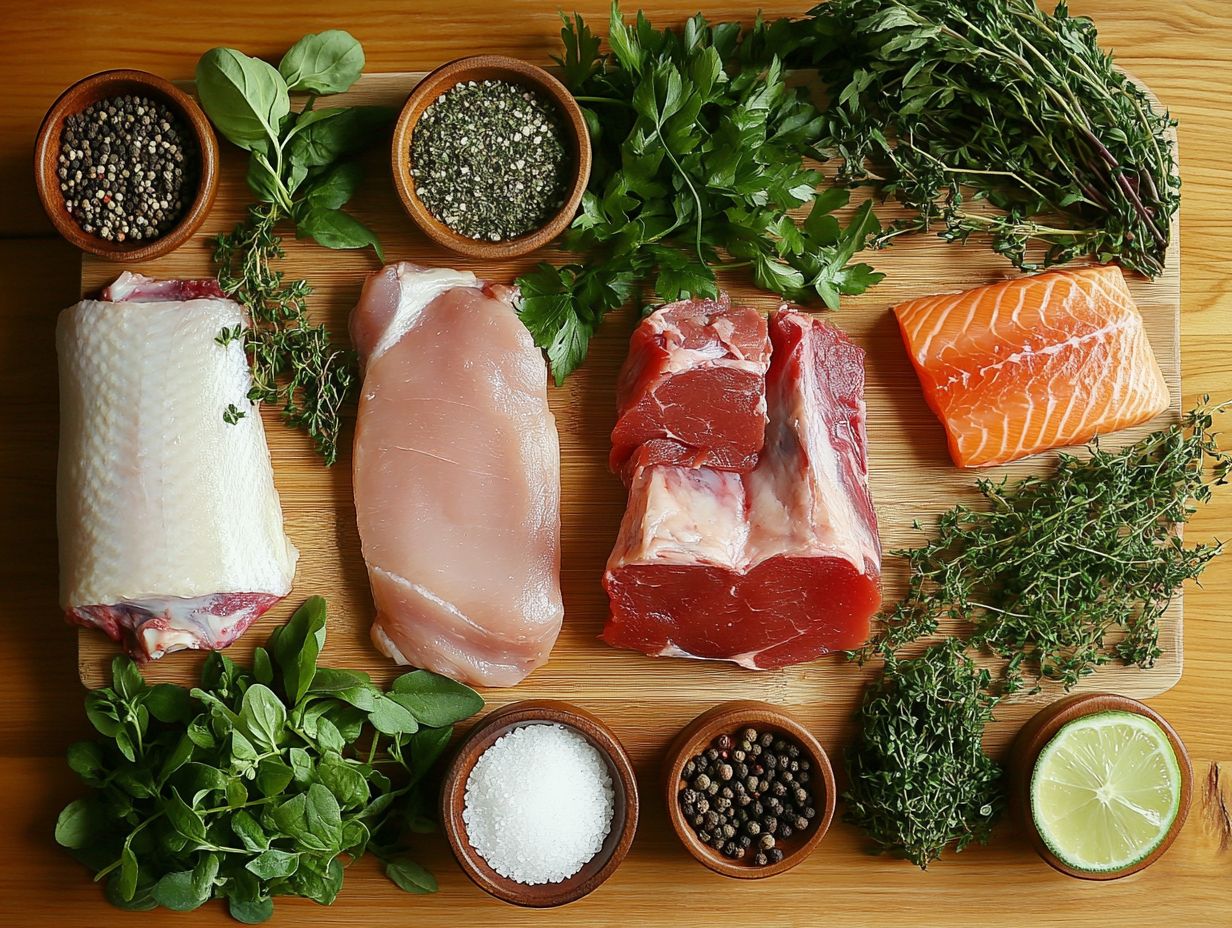
Certain cuts of meat may be labeled as high-carb, and this can throw off the delicate carbohydrate balance that is essential for a successful keto diet.
Understanding the carbohydrate content of various meats is vital for you if you’re aiming to maintain ketosis or simply want to embrace a low-carb lifestyle. For example, some meats like sausages, breaded chicken, and various processed deli meats often contain added sugars or fillers that can significantly elevate their carbohydrate levels. Being aware of these options allows you to steer clear of unintentional carb overloads.
To make informed meat selections, it’s important to master the art of reading ingredient labels. This means checking for hidden carbohydrates buried in the ingredients list and prioritizing cuts like beef, pork, and poultry, which tend to be lower in carbs. By doing so, you can ensure that your choices align perfectly with your dietary goals and support a healthy lifestyle.
3. Grain-Fed Meats
You should generally steer clear of grain-fed meats when following a ketogenic diet. Not only do they offer inferior nutritional value compared to their grass-fed counterparts, but they may also contain higher carbohydrate levels.
On the other hand, opting for grass-fed meats can bring a wealth of health benefits. You’ll love how these meats pack a powerful nutrient punch! They are richer in omega-3 fatty acids, which are vital for heart health and reducing inflammation in your body. Options like these often contain higher levels of antioxidants and essential vitamins, such as vitamin E, crucial for strengthening your immune system.
When choosing your meat, aim for labels that proudly declare “grass-fed” or “pasture-raised.” These terms indicate superior animal welfare and better nutrition for you. Don’t forget to look for certification seals as well; they can guide you toward more wholesome choices in your dietary journey while positively impacting the environment.
What Are the Best Meat Cuts for Keto?
Understanding the finest meat cuts for keto is crucial for anyone truly committed to embracing a ketogenic lifestyle while enjoying delicious meals and indulgent flavors.
1. Fatty Cuts of Beef
Fatty cuts of beef, like bison ribeye steak and ground beef, are among the best choices for anyone following a keto diet due to their rich flavor and high-fat content.
These selections aren t just mouthwatering; they play a vital role in achieving the right mix of fats, proteins, and carbs essential for a successful ketogenic lifestyle. Other top-tier cuts that seamlessly fit into this dietary approach include ribeye steaks, brisket, and short ribs all brimming with healthy fats that provide sustained energy while keeping your carbohydrate intake in check.
The nutritional profiles of these beef cuts typically highlight high levels of unsaturated fats, essential vitamins, and minerals, which support your overall well-being. These cuts are particularly rich in vitamin B12, crucial for maintaining a healthy micronutrient profile. To elevate their taste, consider cooking methods like slow cooking, grilling, or searing. These techniques lock in moisture and enhance the flavors, turning every meal into a truly satisfying experience.
2. Fatty Cuts of Pork
For those devoted to the ketogenic way, fatty cuts of pork, like pork belly, offer an unparalleled combination of flavor and high-fat content.
These cuts align perfectly with the high-fat, low-carb requirements essential for achieving ketosis and serve as an excellent source of protein, which is crucial for building and repairing tissues. Options like pasture-raised and grass-fed pork increase the nutritional value and provide higher omega-3 fatty acids.
You might also want to explore other flavorful options like pork shoulder and spare ribs, which can enhance your meals while keeping carbohydrate counts delightfully low. Whether you savor the melt-in-your-mouth texture of a slow-cooked pork butt or the crispy exterior of a perfectly seared pork chop, the versatility of these cuts in the kitchen is impressive. Consider including some plain unprocessed meat options in your meat recipes for a more natural diet.
Employing techniques such as braising, roasting, or smoking will elevate these pork cuts, bringing out their natural flavors and ensuring a delightful dining experience that aligns seamlessly with your dietary goals.
3. Fatty Cuts of Lamb
Fatty cuts of lamb truly shine as healthy foods within a keto-friendly diet, brimming with healthy fats and essential amino acids. Cuts like lamb shoulder, leg, and rib chops not only deliver robust flavors but also serve as an excellent source of energy for those embracing a low-carb lifestyle.
Lamb boasts a unique fat profile that includes both saturated and unsaturated fats, making it a versatile choice that can help you feel satisfied while supporting your overall health. Incorporating these cuts into your meals can be both gratifying and beneficial, especially when you opt for preparation methods like slow roasting, braising, or grilling.
These techniques enhance their rich flavors while keeping you firmly within keto guidelines. Pairing them with low-carb vegetables creates a well-rounded plate that aligns seamlessly with your nutritional goals.
4. Fatty Cuts of Poultry: Chicken, Duck, and More
Fatty cuts of poultry, like chicken wings and duck, make exceptional additions to your keto diet thanks to their rich flavors and high protein content. These cuts aren’t just delicious; they’re also loaded with healthy fats that boost your energy levels and keep you feeling satisfied, making them ideal for anyone embracing a low-carb lifestyle.
By incorporating these flavorful options into your meals, you can enhance your overall nutrition and culinary enjoyment. Including organic meats can further enhance the health benefits and support animal welfare.
For example, when you roast chicken thighs with a blend of herbs and spices, you achieve that delightful crispy exterior while the meat remains tender and juicy, tantalizing your taste buds. Slow-cooking duck in a savory sauce transforms it into a luxurious dish that pairs beautifully with low-carb vegetables, highlighting the versatility of these cuts.
Don t shy away from experimenting with various cooking techniques, like grilling or smoking, to elevate your experience with fatty poultry. This ensures that every meal is not only delicious but also perfectly aligned with your keto principles.
5. Fatty Fish: Salmon, Wild-Caught, and More
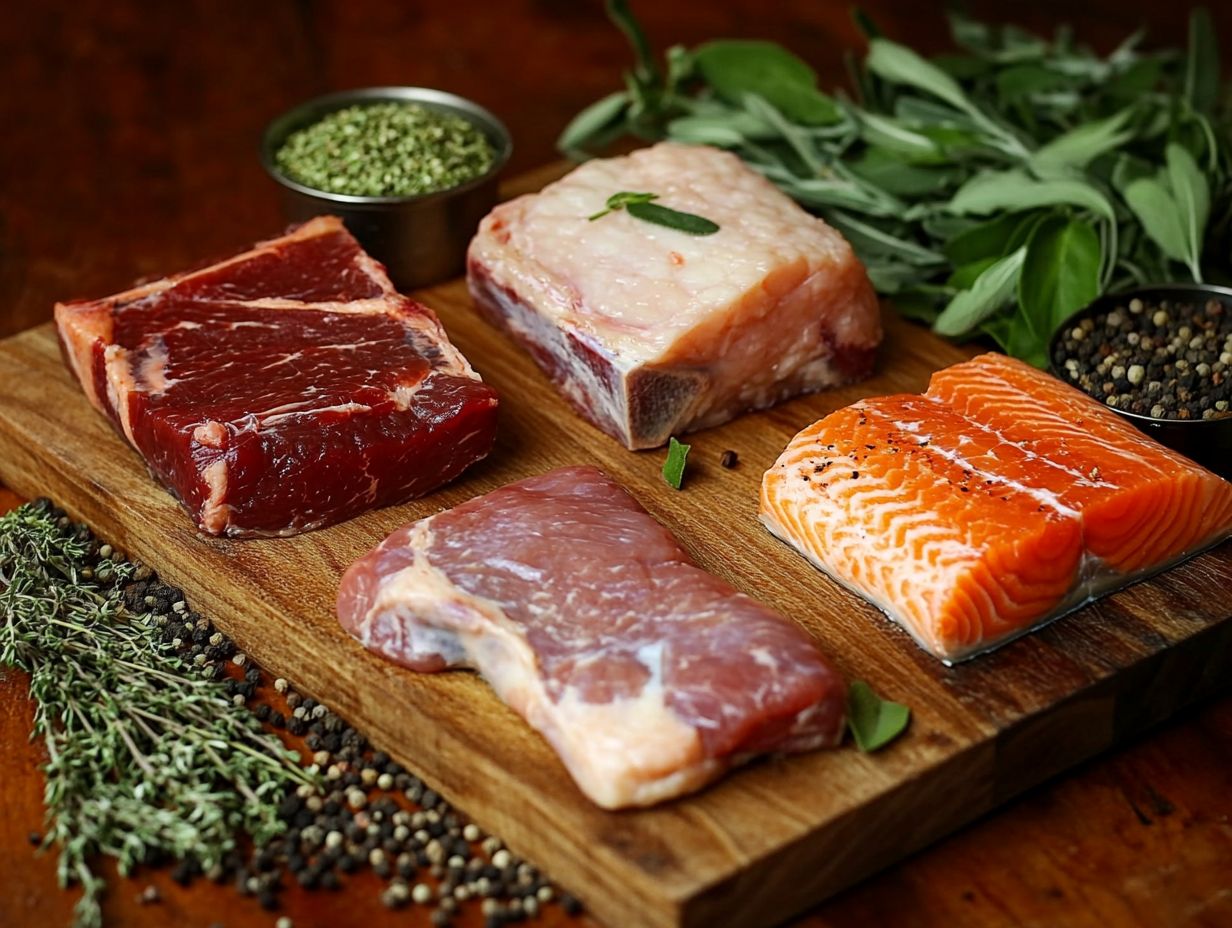
Fatty fish, such as wild-caught salmon, stand out as some of the finest choices for those following a keto diet, presenting a wealth of healthy fats that are great for your heart along with a multitude of health benefits. These nutrient-rich foods are brimming with protein, essential vitamins, and minerals, making them an ideal addition to your low-carb lifestyle. Be sure to check ingredient labels to ensure you’re choosing sugar-free and keto-friendly options.
The impressive omega-3 content in fatty fish plays a vital role in promoting heart health, reducing inflammation, and supporting cognitive function. To seamlessly integrate these delicious seafood options into your keto regimen, consider whipping up recipes like pan-seared salmon with avocado salsa or creamy lemon garlic butter shrimp.
Methods such as grilling, baking, or poaching not only elevate their natural flavors but also ensure that your meals remain healthy and in alignment with keto principles, promising a delightful culinary experience.
6. Organ Meats
Organ meats are often overlooked, yet they offer incredibly healthy options for those of you on a keto diet, brimming with vitamins and minerals that bolster overall health.
Incorporating organ meats like liver, heart, and kidneys into your meal plan can significantly enhance your nutrient intake. These cuts are not just rich in essential vitamins such as A, B12, and iron; they also provide healthy fats that align beautifully with keto principles.
You might be surprised to learn that preparation is simpler than you think. For instance, liver can be pan-seared with garlic and herbs, resulting in a delightful dish, while heart can be chopped and tossed into stews or grilled on skewers for a savory treat.
Consider recipes like p t and organ meat chili, which showcase these ingredients in a manner that even the most hesitant foodies will appreciate. This way, you can enjoy the robust benefits of these powerhouse foods without compromising on flavor.
Cooking Tips and Techniques for Keto-Friendly Meat Cuts
Cooking keto-friendly meat cuts demands a keen focus on techniques that enhance flavor and preserve their nutritional benefits. By doing so, you ensure that your meals are both delicious and perfectly aligned with your low-carb objectives. Consider the environmental impact and opt for grass-fed beef or wild-caught fish when possible.
1. Grilling
Grilling is a fantastic method for preparing keto-friendly meats. It enhances their natural flavors and allows excess fat to drip away, keeping your meals aligned with dietary goals.
This technique elevates the taste while complementing a low-carb lifestyle that emphasizes high-quality proteins. Include cooking methods that preserve the nutritional value of your ingredients.
When selecting your meats, consider the rich offerings of fatty cuts like ribeye, pork belly, and chicken thighs. These options truly shine on the grill, delivering robust flavors and satisfying textures. To achieve the best results, be sure to preheat your grill. This will help you achieve beautiful sear marks while locking in moisture. For an added nutrient boost, select grass-fed or pasture-raised options when available.
Experiment with seasonings. A blend of garlic powder, smoked paprika, and a pinch of salt can elevate the meat s profile, making it even more tempting. For added depth of flavor and tenderness, try marinating your meats in a mixture of olive oil, lemon juice, and herbs a few hours before grilling.
Each grilling session can become a delightful culinary experience.
2. Roasting
Roasting is an exceptional method for preparing indulgent fatty cuts of meat. It allows for even cooking while preserving moisture and flavor in every bite. Roasting not only brings out incredible flavors but also boosts the nutritional benefits of your dish.
To achieve outstanding results, it s crucial that you set the oven temperature just right. A common guideline for keto-friendly meats, such as pork belly or prime rib, suggests starting at 375 F (190 C) for the initial phase, then lowering it to around 325 F (163 C) to finish the cooking process.
For instance, a pork shoulder typically requires about 25 to 30 minutes per pound, aiming for an internal temperature of 190 F (88 C) to guarantee melting tenderness and an unforgettable flavor explosion!
Once the roasting is complete, let the meat rest for 15 to 20 minutes before slicing. This crucial step allows the juices to redistribute, resulting in a richer taste experience.
Pair your masterpiece with a side of roasted vegetables or a fresh, keto-friendly salad to create a beautifully balanced meal.
3. Slow Cooking
Slow cooking is an exceptional method for transforming tougher cuts of meat into tender, flavorful dishes that fit beautifully within a high-fat keto diet. This technique works wonders as the collagen in the meat gradually breaks down, resulting in a melt-in-your-mouth texture that elevates those rich flavors to new heights. This method is ideal for cuts like bison ribeye and venison, known for their rich flavors and nutrient-dense profiles.
With a slow cooker, you can effortlessly craft sumptuous meals while spending minimal time in the kitchen ideal for your busy lifestyle. Cuts such as chuck roast, pork shoulder, and short ribs are particularly well-suited for this approach, eagerly soaking up spices and seasonings to yield truly satisfying dishes.
Whether you re whipping up a hearty beef stew, a zesty pulled pork, or a creamy herb-infused chicken, slow cooking simplifies meal prep and ensures that the keto-friendly flavors are not only intensified but also perfectly balanced.
4. Pan-Frying
Pan-frying is not just easy; it s also incredibly rewarding for keto-friendly meats. It allows you to embrace healthy fats while achieving that coveted crispy exterior. It’s one of the best methods for lean protein options like chicken, beef, pork, and ground beef.
This technique enhances the flavor profile of various meats, including chicken thighs, pork chops, and beef steaks. To start your cooking adventure, selecting the right oils is essential. You can try oils like avocado oil, ghee, or coconut oil because they have high smoke points and offer health benefits.
For added culinary variety, explore pan-frying game hen or wild boar for a unique and flavorful experience.
When you pan-fry, remember to ensure that the meat is dry before seasoning, as excess moisture can thwart a proper sear. Preheating your pans is equally important for achieving that golden crust you desire.
If you’re in the mood to experiment, consider these delightful recipe ideas:
- Crispy chicken thighs seasoned with garlic and paprika
- A rich, buttery steak paired with saut ed mushrooms
These dishes excite your taste buds. They also inspire your creativity in a keto lifestyle. Always check ingredient labels to avoid hidden carbohydrates and maintain a low-carb lifestyle.
Frequently Asked Questions about Keto Meats
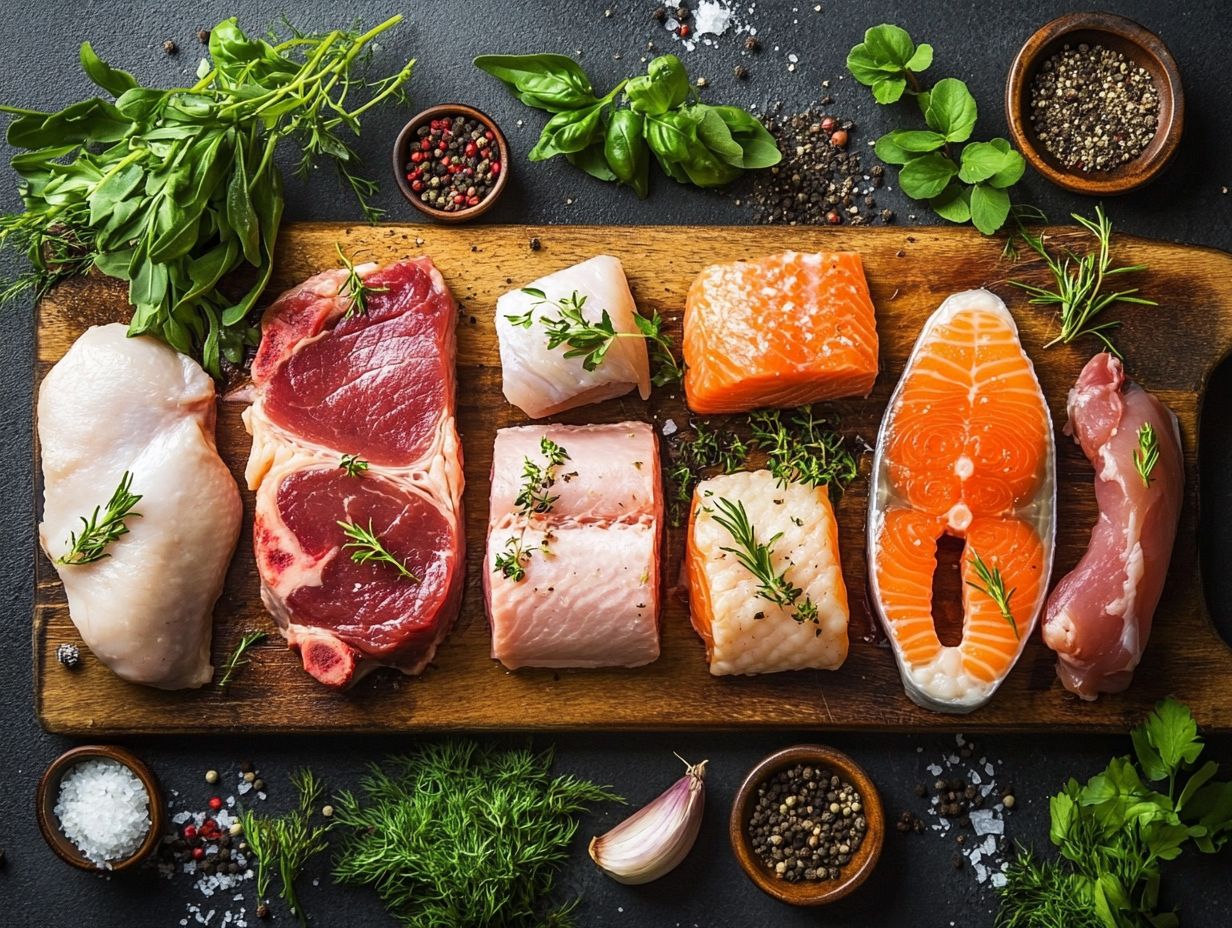
What are the top keto-friendly meat cuts to choose from? (Including Grass-fed and Pasture-raised Options)
The top keto-friendly meat cuts include grass-fed beef, organic meats like chicken, turkey, pork, lamb, and fatty fish like wild-caught salmon and sardines. You can also try fatty cuts such as pork belly and nutrient-dense options like bison ribeye for a ketogenic way of eating.
How can I tell if a meat cut is keto-friendly? (Understanding Nutritional Value and Avoiding Processed Meats)
Look for cuts that are high in protein and healthy fats while being low in carbohydrates. Avoid processed meats and opt for organic, pasture-raised options whenever possible. Always check ingredient labels to ensure there are no added sugars or fillers.
What are some examples of keto-friendly red meat cuts?
Examples of keto-friendly red meat cuts include ribeye steak, flank steak, ground beef, and beef tenderloin. These cuts are high in fat and protein, making them perfect for a keto diet. Consider adding nutrient-rich organ meats and venison to your diet for a wider nutrient profile.
Are all poultry cuts considered keto-friendly? (Identifying Lean Protein and Fatty Cuts)
No, not all poultry cuts are keto-friendly. Avoid breaded and processed poultry, and opt for skin-on cuts like chicken thighs and wings, which are higher in fat and protein. Duck and game hen are also great options for a low-carb lifestyle.
Can I include deli meats in a keto diet? (Choosing Sugar-Free and Nutrient-Dense Options)
Some deli meats can be included in a keto diet, but it’s important to read labels and choose options that are sugar-free and free from added fillers. Deli meats like turkey, chicken, roast beef, and plain unprocessed meat are typically safe choices. Always consider the overall nutrient profile and health benefits when selecting deli meats.
How can I prepare keto-friendly meat cuts? (Cooking Tips for High-Fat Diets)
Keto-friendly meat cuts can be prepared in various ways, including grilling, roasting, and saut ing. Season with herbs and spices, and use healthy fats like olive oil or ghee to enhance the flavor. Incorporating different cooking methods provides culinary variety and helps maintain a healthy lifestyle.

